Roasted Broccoli Asparagus Salad
This roasted broccoli asparagus salad is tossed in a creamy roasted garlic lemon dressing that will make you excited about getting your vegetables in.
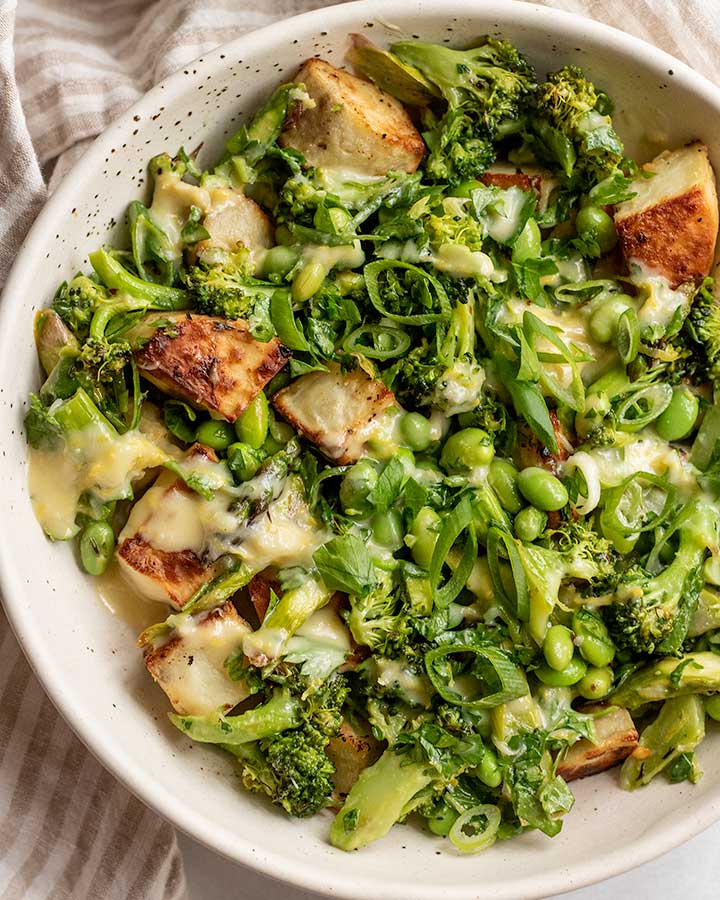
All I want are good salads. And now that more vegetables are in season, building epic salads you actually want to eat becomes easier.
Yes, salads can be good for you, but that doesn’t mean that they can’t taste good. And a big key is in how you prepare said vegetables for the salad. As long as you have good seasoning techniques, play with different textures and have a killer dressing, the skies the limit for some yummy bowls.
Why You’ll Love Broccoli Asparagus Salad
- Budget Friendly. Made with seasonal and affordable produce. Bonus, buying seasonal produce also makes your produce taste better, which will lead to a better tasting salad.
- Filling and satisfying. This salad has a bright tangy flavor thanks to the roasted garlic lemon dressing. It makes eating this hearty salad that much more enjoyable.
- Full of spring time flavor. If you are transitioning from winter to spring, this is the perfect salad. It marries the textures and flavors of both seasons and can be eaten warm if still dealing with colder weather.
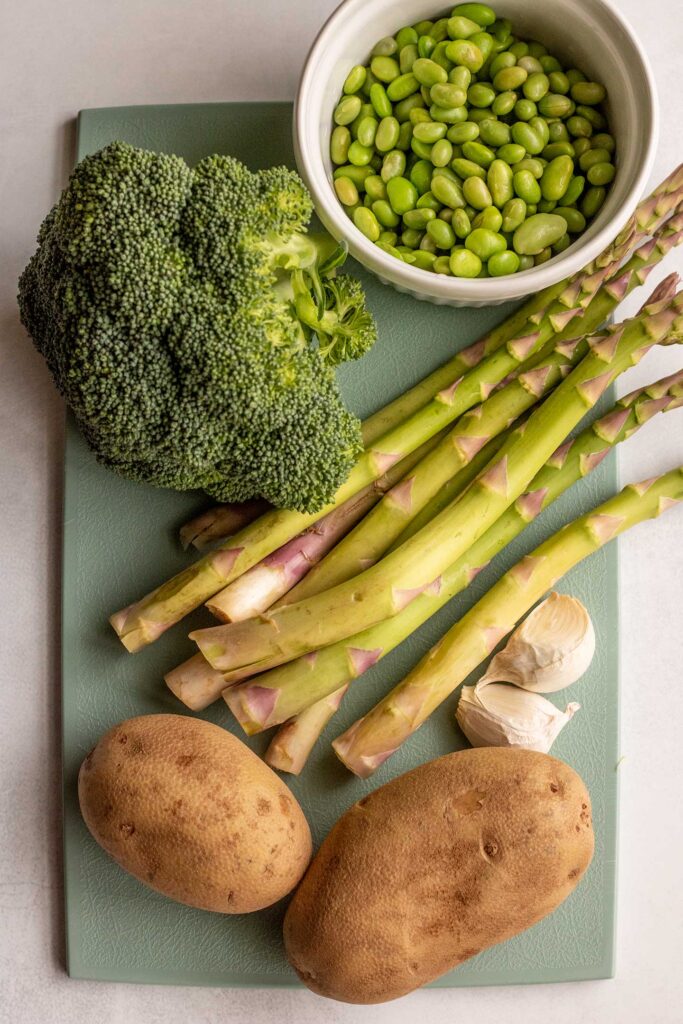
Key Ingredients and Substitutions
- Potatoes: I used Russet Potatoes as I had them on hand. You can try this recipe also with Yukon gold or red potatoes too.
- Broccoli: I recommend cutting this down into smaller bite size pieces. If you use bigger florets they will need more time in the oven to roast.
- Asparagus: If you can, opt for some thicker asparagus spears. If not a fan of asparagus try zucchini or snap peas.
- Garlic: I used 2 large cloves. Feel free to use more if using smaller cloves.
- Lemon: Do use fresh lemon as you need both the zest and juice for this.
- Mustard: I recommend Dijon mustard. It has the right bite and tang to complement the lemon in the dressing.
- Maple Syrup: This will help balance some of the tang of the dressing. Feel free to swap with another liquid sweetener like agave syrup if desired.
- Yogurt: I used a plain unsweetened plant-based yogurt. My go to options are either Forager Project cashew yogurt or Silk’s Soy yogurt.
- Edamame: For some protein, I used some thawed edamame. You can always swap with other beans you love or some roasted tofu.
How to Make Roasted Broccoli Asparagus Salad
Preheat oven to 425F then bring a pot of water to a boil and add the baking soda and 1 tablespoon of salt.
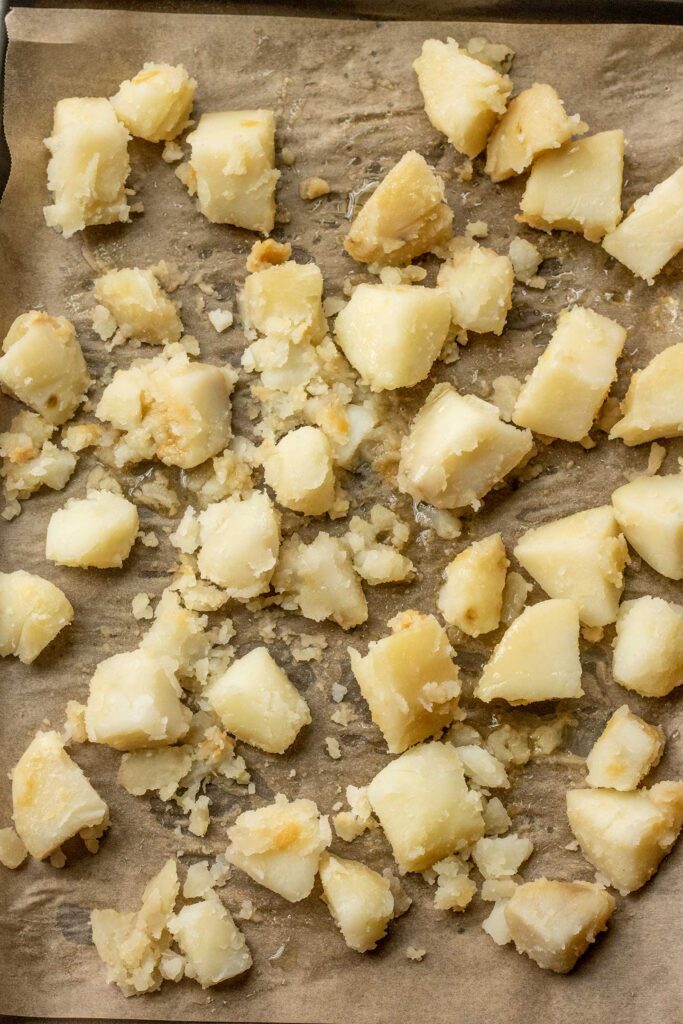
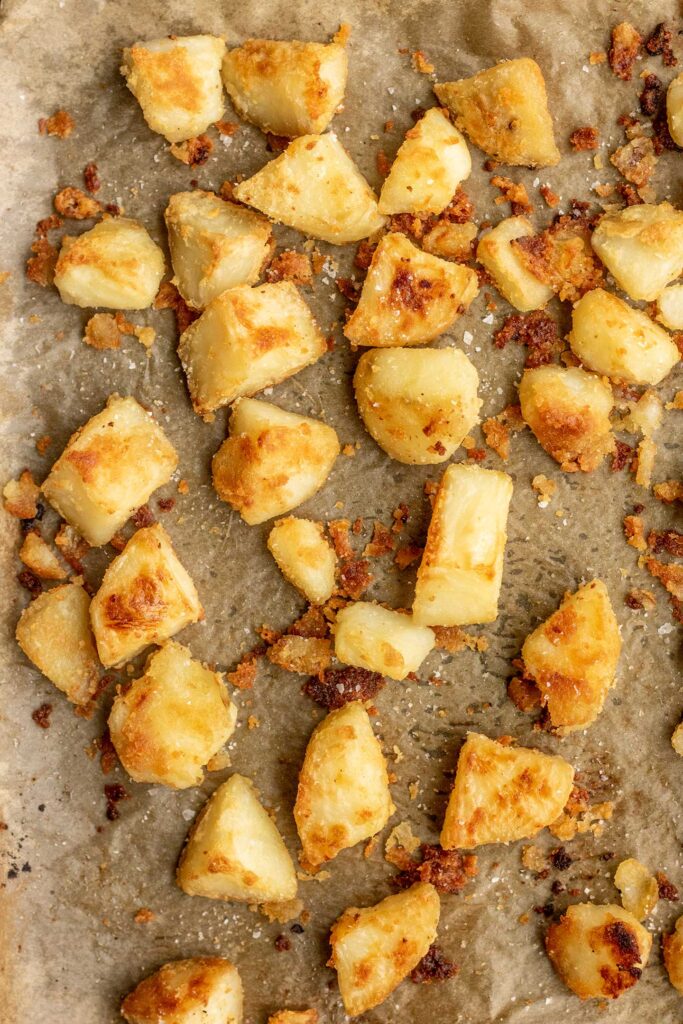
Once the water is boiling, add the potatoes and cook them for 8-10 minutes or until fork tender. Strain the potatoes and place them on a parchment lined baking tray with a generous pinch of salt and 1 tsp each garlic powder and onion powder. Place the garlic cloves on the tray with the potatoes and drizzle the tray with about 1 tablespoon or more of oil (use the amount you are comfortable with).
Toss everything to coat, spread out into a single layer and place the tray on the bottom rack and roast for 25-30 minutes, giving them a toss half way.
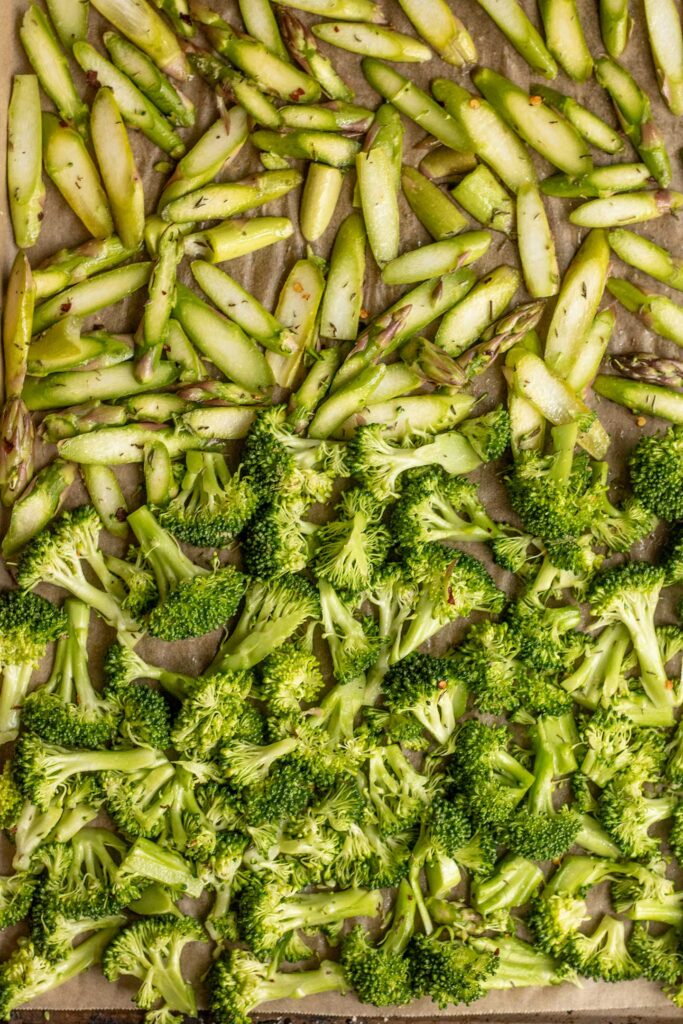
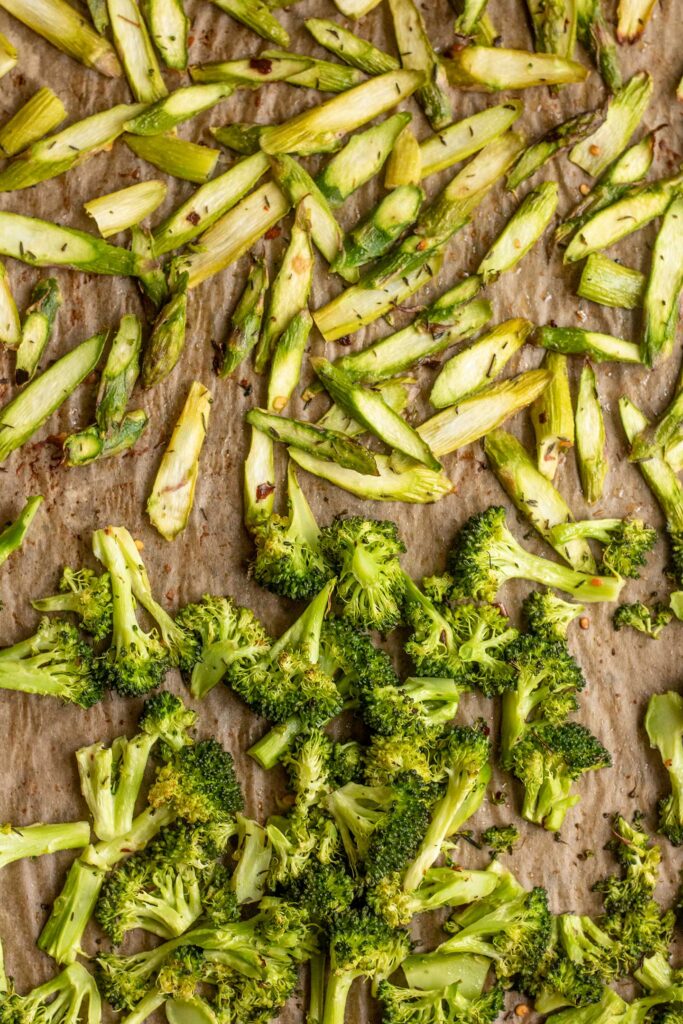
To a separate tray add the asparagus and broccoli. Top with dry thyme, a pinch of salt and the remaining garlic and onion powder. Drizzle with oil, toss to coat evenly and spread out in a single layer. Place this tray on the top rack and roast for 12-15 minutes, tossing half way.
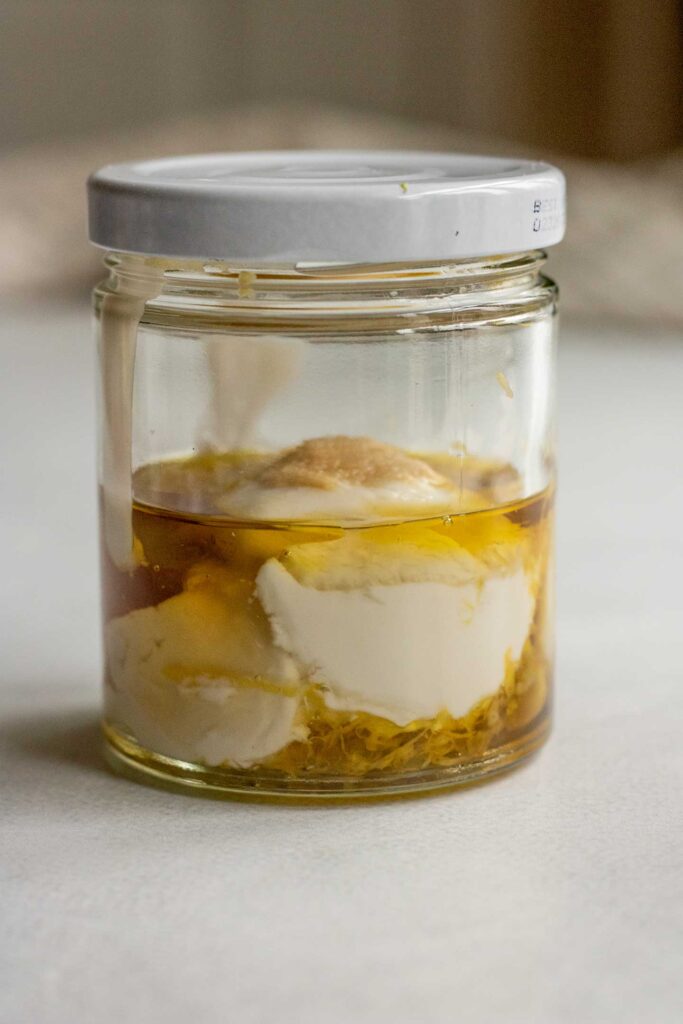
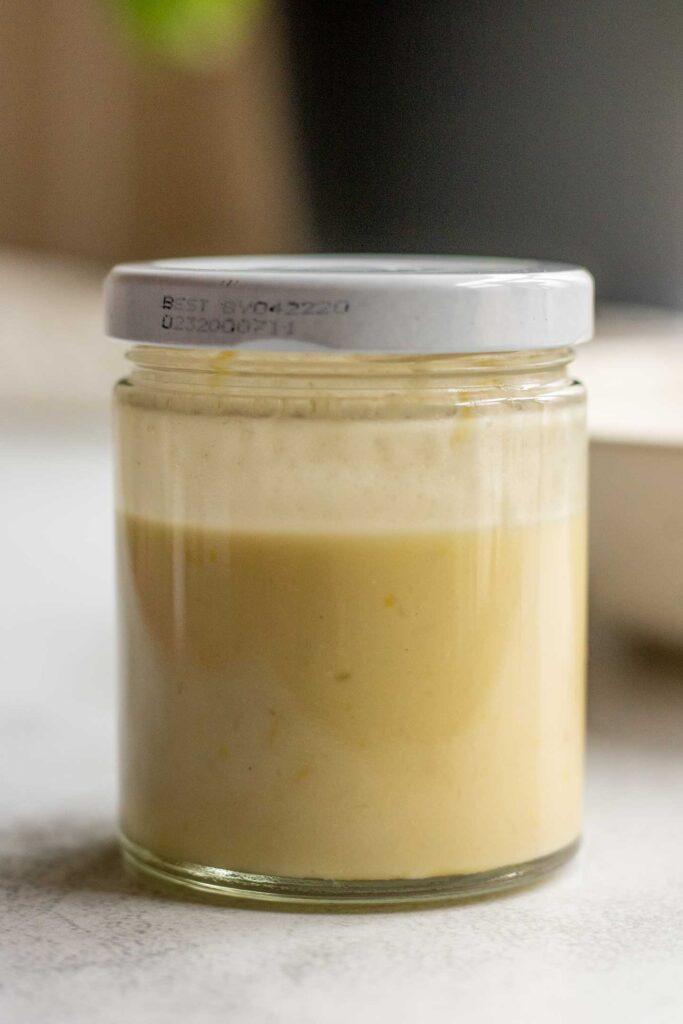
Remove the roasted garlic cloves, when safe to handle, peel it and place on a cutting board. Smash the cloves with the flat side of your knife, scrape it up and place in a small bowl or jar along with the lemon zest and juice, yogurt, oil, maple syrup, mustard, and a pinch of salt. Whisk or shake the ingredients together until creamy and set aside.
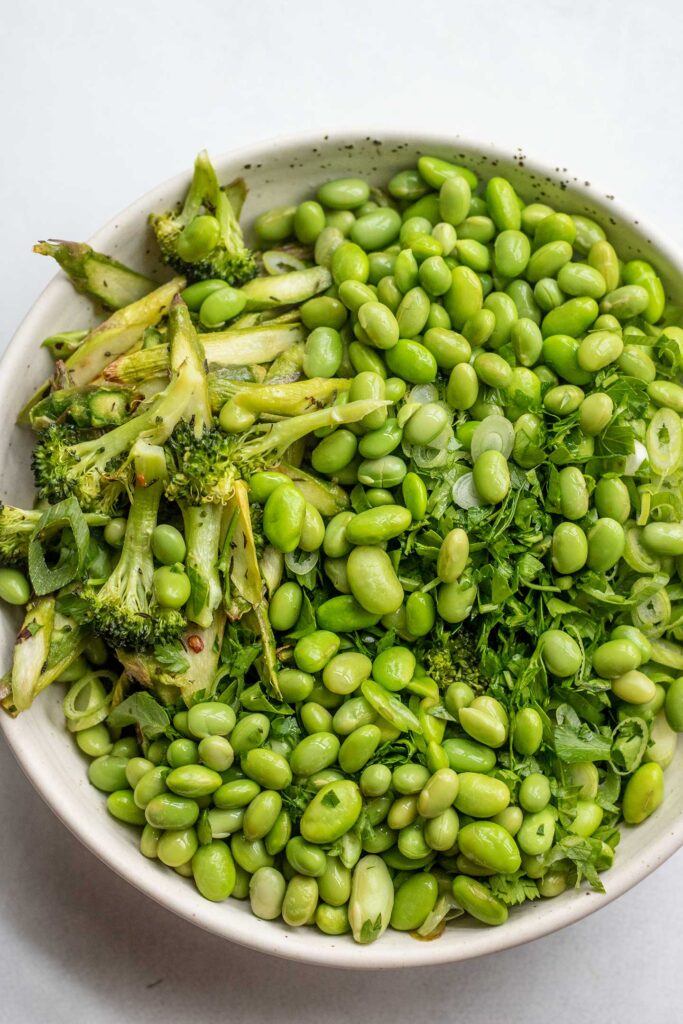
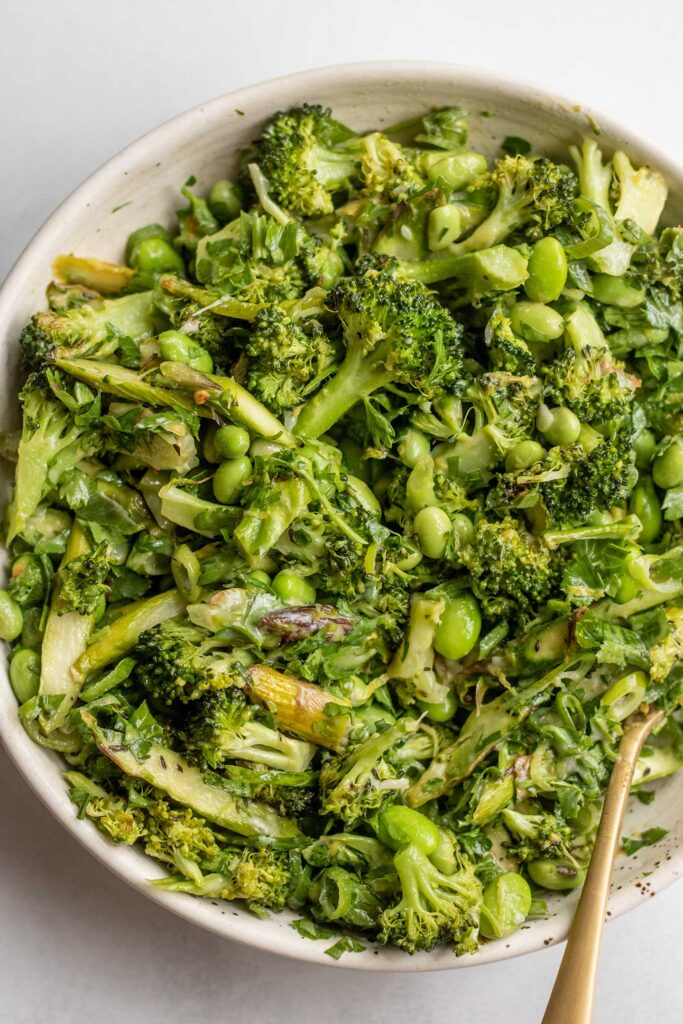
Add the roasted broccoli, asparagus, scallions, herbs, and edamame to a large mixing bowl. Pour half the dressing over top and toss to coat.
To serve, divide the potatoes between serving plates, spoon over the broccoli mixture and drizzle with more dressing if desired.
Expert Tips
- Add baking soda to your boiling water when cooking your potatoes. This will help break down the starches around the edges of your potatoes, which will help to crisp them up better in the oven when baked.
- Use the amount of oil you prefer. I provide suggestions for the optimal flavor and texture to this dish. You can use more or less to coat your produce appropriately. If you choose to use less, just note that it may impact the browning, flavor and texture of some of your ingredients when roasting.
- Cut your vegetables into even pieces. This will make sure that your vegetables all cook evenly and at the same time.
- Season throughout. We are adding salt and using it in different ways to impart flavor in this dish. Do note that the salt used to boil the potatoes in is used the same way you would salt your water with pasta. You will not ingest all of that sodium, most of it will still remain in the water. A little bit of that sodium will be able to get in the potatoes to impart some flavor.
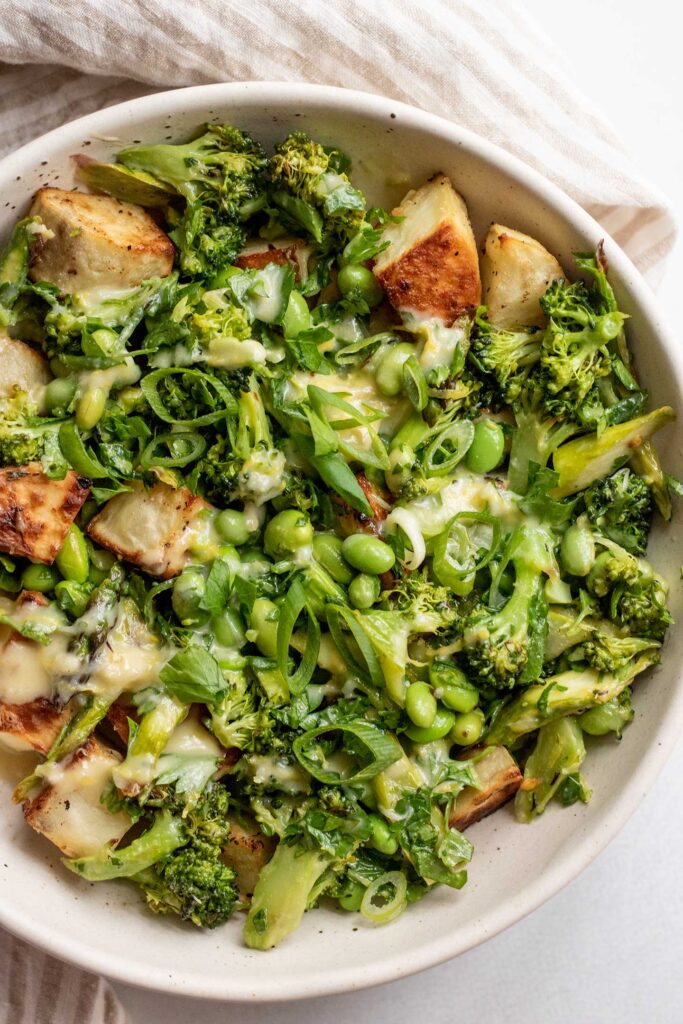
Frequently Asked Questions
Allow the broccoli and asparagus portion of the salad (without the potatoes) to cool completely before storing in an airtight container in the fridge. It is good mixed with the dressing for up to 4-5 days. You can roast some fresh potatoes when you plan to enjoy or enjoy the mix with another grain of choice. If making the dressing in advance or saving leftovers, store in an airtight container and place in the fridge for up to 7 days.
You can warm it up or eat it cold. If warming up, just place in a pan or in the oven to heat through before adding to your bowl.
Totally up to you. Just note you should always scrub your potatoes really well to remove any dirt from the surface. Do note, as the potatoes boil, the skins might come off naturally. If you want to preserve the skins better, you may wish to steam your potatoes instead.
A lot of plant-based foods naturally contain fiber. If you are looking for some specific recommendations you can always start with incorporating more dark leafy greens (think kale, Swiss chard, collard greens, etc.), cruciferous vegetables (brussels sprouts, broccoli, cauliflower, and cabbage), potatoes, and corn.
How to Serve
I love pairing the broccoli asparagus salad with some roasted potatoes. However, feel free to swap the potatoes for some cooked rice or quinoa. For more protein, you may want to add some crispy tofu or tempeh.
More Hearty Salad Recipes to Try
- Smashed Cucumber Avocado Salad
- Herby Avocado White Bean Salad
- Herby Rice Salad with Crispy Za’atar Chickpeas
- Roasted Lentil Potato Salad
- Avocado Mango Salad Bowl
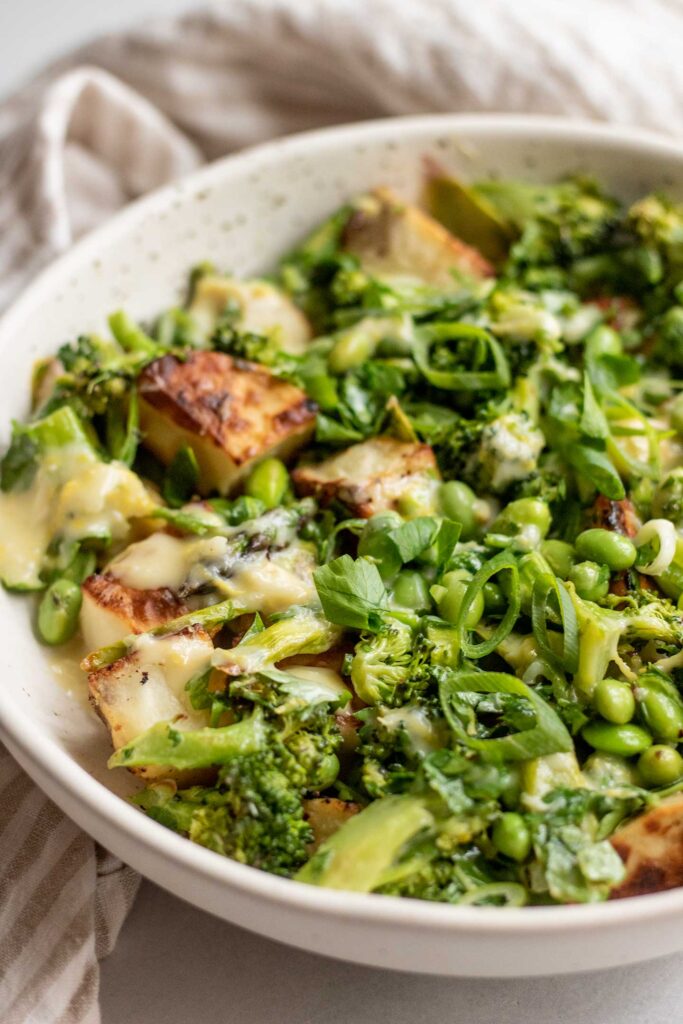

Roasted Broccoli Asparagus Salad
- Prep Time: 15 minutes
- Cook Time: 45 minutes
- Total Time: 1 hour
- Yield: 4 servings 1x
- Category: Salad
- Method: Roasting
- Cuisine: American
- Diet: Vegan
Description
This roasted broccoli asparagus salad is tossed in a creamy roasted garlic lemon dressing that will make you excited about getting your vegetables in.
Ingredients
- 1.5 lbs Russet potatoes, peeled and cut into 1 inch cubes
- 1 tsp baking soda
- 1 medium head of broccoli, diced into 1/2 inch bite size pieces
- 4 oz of asparagus (about 8 thick spears), cut thinly on a bias
- Oil for roasting
- 2 tsp garlic powder
- 2 tsp onion powder
- 1/2 tsp dry thyme
- 2 cloves of garlic in their peels
- Zest and juice of 1 lemon
- 2 tbsp unsweetened plant-based yogurt
- 2 tbsp extra virgin olive oil
- 2 tsp maple syrup
- 1 tsp Dijon mustard
- 2 scallions, thinly sliced
- 1/4 cup fresh parsley or dill, minced
- 1 1/2 cups frozen edamame, thawed
- Salt
Instructions
- Preheat oven to 425F then bring a pot of water to a boil and add the baking soda and 1 tablespoon of salt.
- Once the water is boiling, add the potatoes and cook them for 8-10 minutes or until fork tender. Strain the potatoes and place them on a parchment lined baking tray with a generous pinch of salt and 1 tsp each garlic powder and onion powder. Place the garlic cloves on the tray with the potatoes and drizzle the tray with about 1 tablespoon or more of oil (use the amount you are comfortable with).
- Toss everything to coat, spread out into a single layer and place the tray on the bottom rack and roast for 25-30 minutes, giving them a toss half way.
- To a separate tray add the asparagus and broccoli. Top with dry thyme, a pinch of salt and the remaining garlic and onion powder. Drizzle with oil, toss to coat evenly and spread out in a single layer. Place this tray on the top rack and roast for 12-15 minutes, tossing half way.
- Remove the roasted garlic cloves, when safe to handle, peel it and place on a cutting board. Smash the cloves with the flat side of your knife, scrape it up and place in a small bowl or jar along with the lemon zest and juice, yogurt, oil, maple syrup, mustard, and a pinch of salt. Whisk or shake the ingredients together until creamy and set aside.
- Add the roasted broccoli, asparagus, scallions, herbs, and edamame to a large mixing bowl. Pour half the dressing over top and toss to coat.
- To serve, divide the potatoes between serving plates, spoon over the broccoli mixture and drizzle with more dressing if desired.
Notes
Add baking soda to your boiling water when cooking your potatoes. This will help break down the starches around the edges of your potatoes, which will help to crisp them up better in the oven when baked.
Use the amount of oil you prefer. I provide suggestions for the optimal flavor and texture to this dish. You can use more or less to coat your produce appropriately. If you choose to use less, just note that it may impact the browning, flavor and texture of some of your ingredients when roasting.
Cut your vegetables into even pieces. This will make sure that your vegetables all cook evenly and at the same time.
Season throughout. We are adding salt and using it in different ways to impart flavor in this dish. Do note that the salt used to boil the potatoes in is used the same way you would salt your water with pasta. You will not ingest all of that sodium, most of it will still remain in the water. A little bit of that sodium will be able to get in the potatoes to impart some flavor.
If you tried this recipe or any other recipe on the blog, then let me know what you thought in the comments below! And if you loved it, don’t forget to rate it too. Feel free to follow on Instagram, Pinterest, and TikTok for the latest nutrition tips and recipe videos.
★ Catherine
This post contains affiliate links which means I will make a small commission if you purchase from those links. I only recommend and share products that I know, trust and personally use myself!




